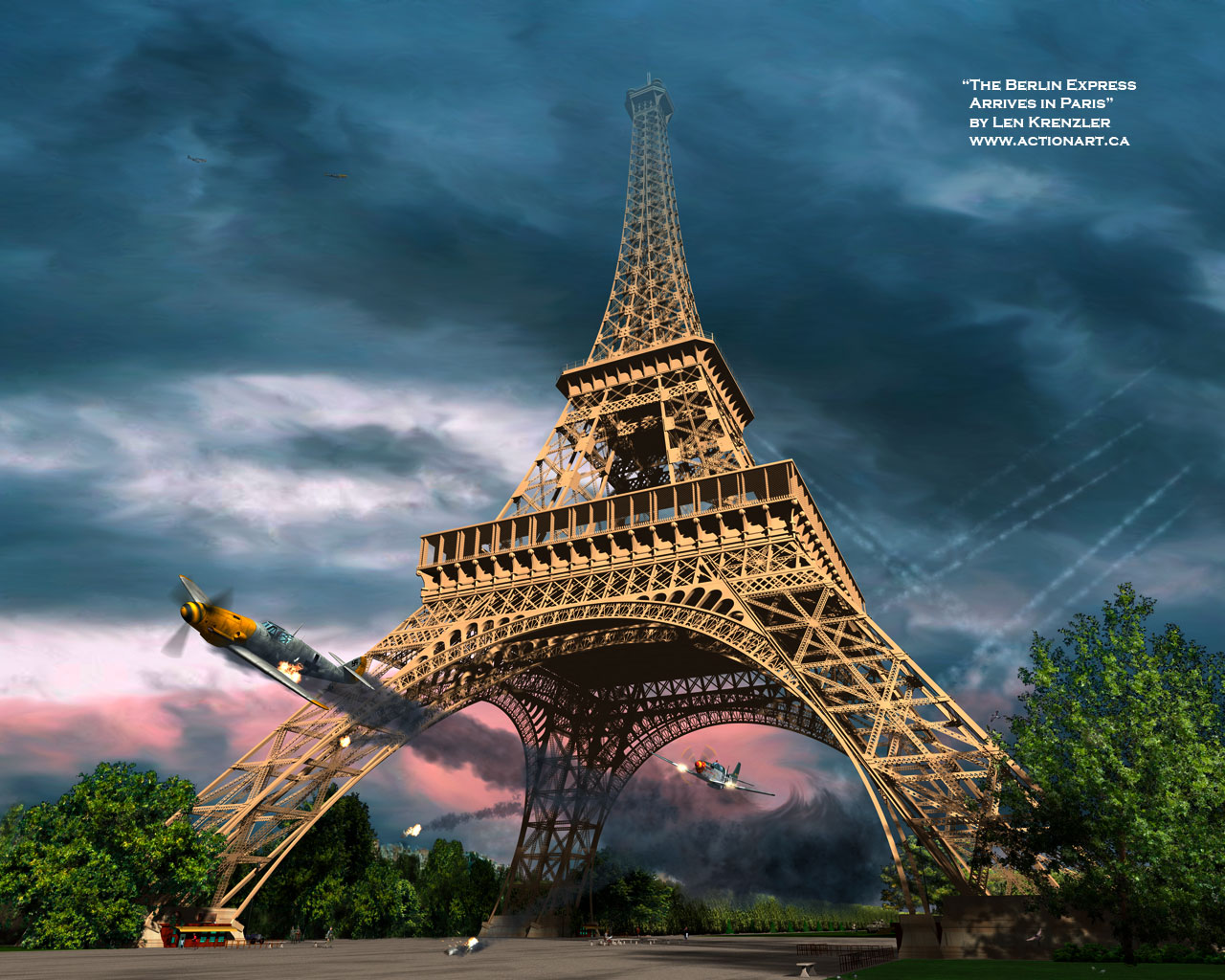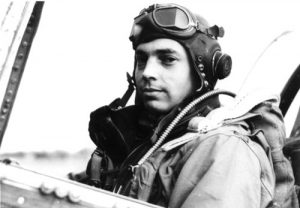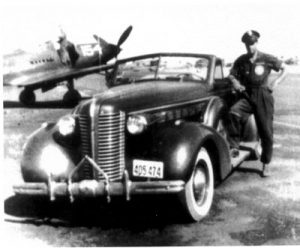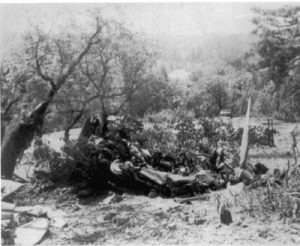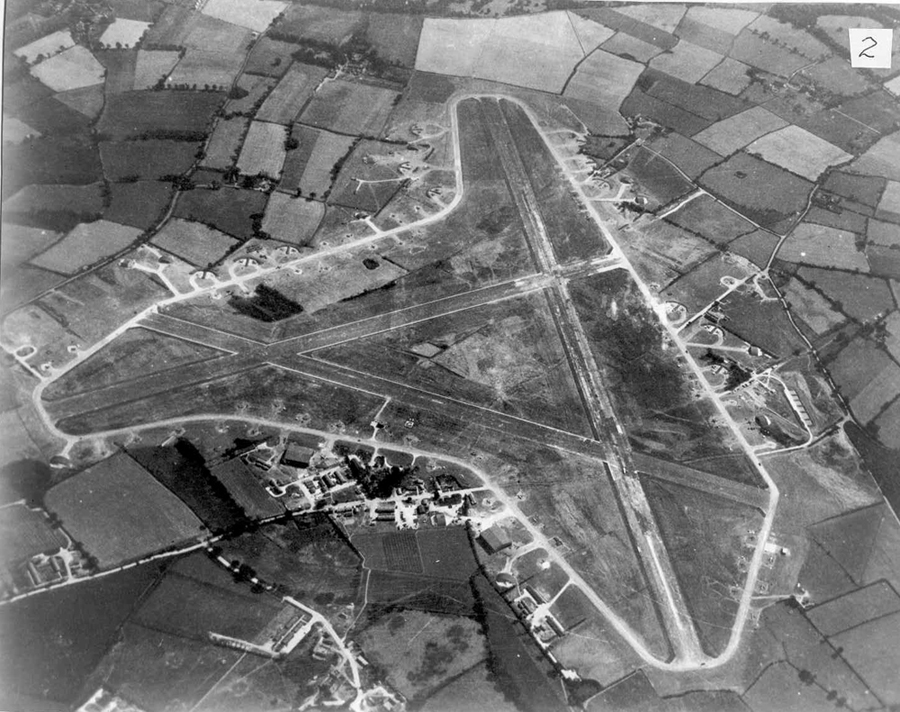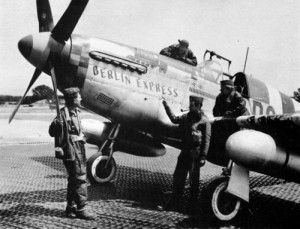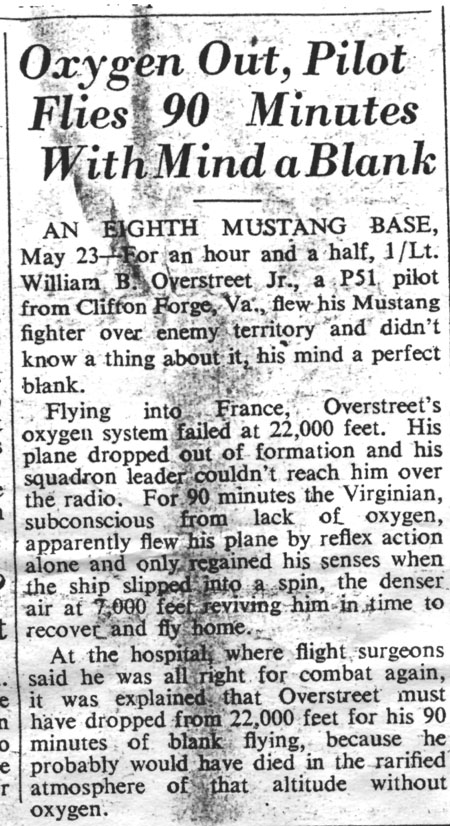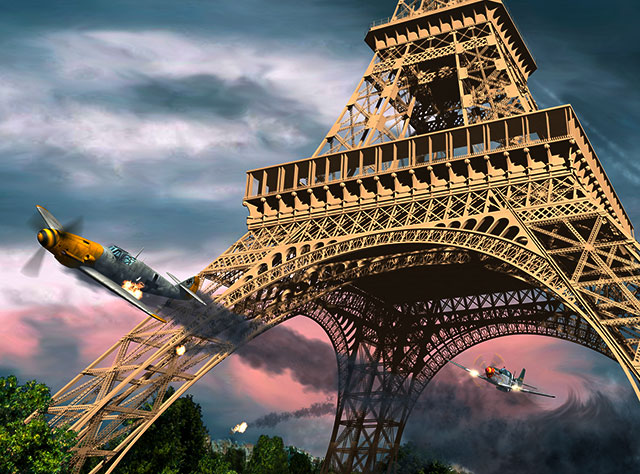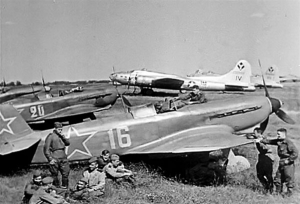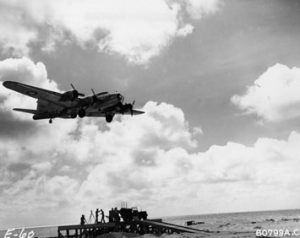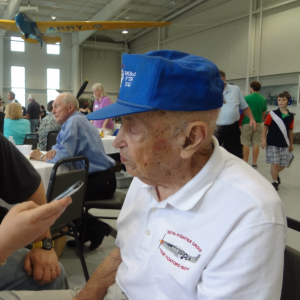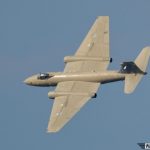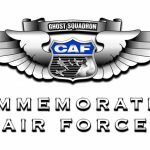We had the pleasure of speaking at length with World War Two aviator, William B.”Bill” Overstreet at Warbirds Over the Beach 2013, and as promised, we’re going to relate some of the compelling stories of his experiences during the war. While he is in his nineties, he is still sharp, and in talking to him, you can still see the spark of the twenty-something daredevil he once was in his eyes as he recounts his exploits, fighting the forces of fascism from the cockpit of a fighter plane over Europe all those years ago.
Hailing from Clifton Forge, Virginia, Bill Overstreet was born on April 10, 1921. On the day the Japanese attacked Pearl Harbor, Bill was working as a statistical engineer for Columbia Engineering and attending Morris Harvey College (now the University of Charleston) in Charleston, WV. Wanting to get in the Air Corps as a fighter pilot, Bill enlisted and did a lot of fast talking to get accepted into the program, and by February 1942 he was a private, waiting for an opening as an Aviation Cadet. After several months, he was sent to Santa Anna, California, for preflight training, and after several months at preflight, he was sent to Rankin Aeronautical Academy in Tulare, California, for primary flight training flying Stearmans.
Tex Rankin, the Rankin school’s founder and chief instructor was a champion aerobatic pilot and often took the opportunity to demonstrate his skills. In keeping with Rankin’s vision, the school employed some unusual methods to produce skilled aviators, including surprising students mid-flight. One story Bill relates is how his instructor, Carl Aarslef, while on the downwind leg of a landing pattern, at 500 feet, would suddenly turn the Stearman upside down, cut the engine, and say, “OK, you land it.” Of course, for Bill it was easy, as he puts it: “just quarter roll it into a left turn, line up with the runway and set it down.” Bill theorizes that the real test was for his reaction to the unexpected, and learning to keep one’s head in an unanticipated situation, where one second can mean the difference between life and death, is a useful skill for a pilot, and was certainly put to use over the course of Bills flying career.
The next phase in Overstreet’s training was basic flight training at Lemoore, California, where he flew the Vultee BT-13 Valiant, a faster and heavier plane than the biplanes utilized in the initial phase of training and introduced aspiring pilots to two-way radio communications with the ground, operating landing flaps and adjustable propeller pitch. The third phase of training took place at Luke Field, in Arizona. Piloting North American T-6 Texans and later on Curtiss P-40 Warhawks was a revelation to Bill, and while the commanding officer had picked Bill for additional training for multi-engined aircraft, Bill was able to convince the CO to instead assign him as a fighter pilot rather than going on to become a bomber pilot.
Upon graduation, Overstreet was initially assigned to Hamilton Field, California. Later he went on to the 357th Fighter Group, 363rd Fighter Squadron. The squadron was being moved from Nevada to Santa Rosa, California, and Bill got to fly with experienced pilots from whom he learned a great deal. Bill throughly enjoyed flying out of Santa Rosa, saying “Flying at Santa Rosa was great. There was enough moisture in the air to leave streamers from the wing tips in a tight turn. Our goal was to get a flight of four, come to the end of the runway, peel up in a tight turn and land before the first plane’s streamers had faded. I flew with several flight leaders, but mostly with Lloyd Hubbard. He was good. We all thought we could buzz pretty closely, but while we may be able to “mow the fairway” on a golf course, only Hubbard could “mow the greens.”
“Hub” also liked to take a flight of four to the Golden Gate Bridge and do loops around it. You know we were having fun! Complaints came in and charges were placed. Jack Meyers, our legal officer, told me years later that he was able to hold up action on bushels of charges, and took most home with him after the war. We liked to buzz farmers, sunbathers or anything. Years later, I asked Don Graham why we got by with so much. He replied, “If you were picking pilots for combat, who would you pick? The fellows who flew straight and level or the ones who pushed the envelope and tested the limits of their planes?” “
Bill was in combat training in June 28th, 1943 when he had his first crash, at the controls of an Bell P-39 Airacobra, which went into a dreaded flat spin, a condition uniquely devastating for the model and which claimed many a pilot’s life. Bill and his squadron-mates were practicing aerobatic maneuvers when his plane strated tumbling and he couldn’t control it. Bill went to release the Airacobra’s doors but the air pressure prevented them from opening. He finally managed to get a knee against one door with his shoulder against the other, trying to overcome the pressure, and the moment he got out, he pulled the ripcord on his parachute. The moment the chute snapped open Bill found himself standing amidst the wreckage of his plane right by the propeller. He was so close to the ground when he escaped his doomed plane that none of his flight-mates even saw his chute deploy, Bill belives he was perhaps the first pilot to survive the crash of a tumbling P-39, and he made a point on tracking down the man who packed his chute to personally thank him for a job well done.
After additional training, flying P-39s in Oroville, California and Casper, Wyoming, Bill was declared “combat ready” and was sent to Camp Shanks in New Jersey before being loaded on the Queen Elizabeth to cross the Atlantic for deployment at Raydon Airfield as part of the Ninth Air Force. There were no planes available at that point, so Bill felt fairly useless there, but as luck would have it, North American P-51 Mustangs were becoming available, and the Ninth Air Force traded Bill’s plane-less squadron for a squadron of pilots and Republic P-47 Thunderbolts with the Eighth Air Force, so Bill found himself stationed at RAF Leiston. Bill got to fly a p-51 for the first time on January 30, 1944, and as the inventory of the planes increased, the opportunity to fly them increased as well.
Bill named his first P-51, which he received in February, 1944 “Southern Belle,” but it was lost along with its pilot on a combat mission a couple of weeks later. Re-thinking the name, given that by that time they were regularly flying sorties to Germany, he named all of his subsequent planes “Berlin Express.” On March 6, 1944 just after their first Berlin raid, the 357th received their first Citation, which stated: “On 6 March, 1944, the newly operational 357th Fighter Group provided target and withdrawal support to heavy bombardment aircraft bombing Berlin, which was the deepest penetration of single-engine fighters to that date. The 33 P-51 aircraft went directly to Berlin and picked up the first formations of B-17s just before their arrival over the city. They found the bombers being viciously attacked by one of the largest concentrations of twin-engine and single-engine fighters in the history of aerial warfare. From 100 to 150 single-engine and twin-engine fighters, some firing rockets, were operating in the immediate target area in groups of 30 to 40 as well as singly. Each combat wing of bombers was being hit as it arrived over Berlin and although they were sometimes outnumbered as much as 6 to 1, flights and sections of the 357th Group went to aid each combat wing as it arrived over the target, providing support in the air for over 30 minutes. Upwards of 30 enemy aircraft at a time were attacked by these separate flights and sections, and driven away from above and below the bombers. Some of the P-51s left their formations to engage enemy fighters below the bomber level in order to prevent them from reforming for further attacks. Though fighting under the most difficult conditions and subjected to constant anti-aircraft and enemy aircraft fire, so skillfully and aggressively were their attacks on the enemy fighters carried out that not a single aircraft of the 357th Group was lost. In driving enemy fighters away from the bombers, 20 Nazi fighters were destroyed, one probably destroyed and seven others damaged. On withdrawal, one flight of five P-51s strafed a large enemy airfield in central Germany, damaging three twin-engine and single-engine aircraft on the ground and killing 15-20 armed personnel before regaining altitude and returning to the bombers.”
Bill relates, “Not long after (the March 6th Mission), I had a freak accident. I think it was a mission to southern France. While over enemy territory, a burst of flak cut my oxygen line. Since I was at about 25,000 feet, I soon passed out. The next thing I knew, I was in a spin, engine dead since the fuel tank it was set on was dry. Somehow, I recovered from the spin, changed fuel setting, got the engine started, and dodged the trees that were in front of me. Then, I looked at my watch. Ninety minutes were not in my memory. I had no idea where I was, but remembered where I had been headed so I reversed it. I was able to find the coast of France and headed for Leiston. By this time, I was low on fuel, so I landed at the Fourth Group base. The officer I talked with was Captain Mead, who had lived a couple of blocks from my home in Clifton Forge, Virginia. To top it off, the mechanic who repaired my plane was “Hot Cha” Tucker, a former schoolmate, also from Clifton Forge. I still have a picture of Tucker and me with a P-47. Many weeks later, this story got a lot of publicity – Lowell Thomas on radio, newspapers and TIME magazine.“
Another mission that didn’t turn out as expected occurred when Bill flew with a sinus infection. He and his group were escorting a sortie of bombers, and in chasing German fighters away from the flight, he engaged in a power dive from 30,000 feet, chasing after a Messerschmitt Bf 109. The extreme change in pressure caused his eyes to swell shut, blinding him. Bill was able to keep his plane in the air by control feel, but had no way to determine his heading or carry out a landing. Calling on his radio for help, one of Bill’s mates, Indicated that he could see Bill’s plane and gave him instructions to get the plane pointed in the right direction, then got on his wing and together the two made their way back to the base in England. Bill was talked through a straight-in approach and landing. It took several days under the care of the Base’s doctors before the swelling had gone down enough for Bill to see again.
(Image Credit: Len Krenzler / Action Art )
In the spring of 1944 Bill and his P-51C “Berlin Express” were near Paris when the scene that is immortalized in the artwork by Len Krenzler of Action Art that leads this article took place. Bill had followed this Bf 109 from the bombers he was escorting when most of the German fighters left. The two planes had been in a running dogfight. The German pilot flew over Paris hoping that the heavy German anti-aircraft artillery would solve his problem and eliminate Overstreet and the “Berlin Express,” though Bill managed to get some hits in at about 1500 feet. The German’s engine was hit, and Bill stayed on his tail braving the intense enemy flak. His desperation undoubtedly growing, the German pilot aimed his plane at the Eiffel Tower and in a surprising maneuver, flew beneath it. Undeterred, Bill followed right behind him, scoring several more hits in the process. The German plane crashed and Bill escaped the heavy flak around Paris by flying low and full throttle over the river until he had cleared the city’s heavy anti-aircraft batteries.
On D-Day, June 6, 1944, Overstreet and his group took off at around 2AM in terrible weather, climbing to about 20,000 feet to get out of the overcast. He recalls it as beautiful when they had finally cleared the clouds, with a bright moon and the sight of all of the aircraft rising from the clouds after their long climb to get above the weather. With all the planes in the air, his wing never did find their assigned flights, so they just formed up in flights of four, knowing that their mission was to get to France and make sure no German fighter planes could interfere with the invasion as well as preventing German reinforcements from being brought up. Their first mission was six hours, then they had to return to base for fuel. His group flew eight missions on the day of the invasion.
June 7th brought a sortie that saw Bill and his mates strafing trains, trucks and military vehicles. On the 10th, more hits on German supply lines were carried out, with attacks on trains, trucks and barges. On the 29th the group’s success continued with Bill knocking out an Fw 190 and with Allied air superiority well established, Bill only used 40 rounds that entire day. General Kepner issued another commendation for the 357th and the 361st Groups, who destroyed 48 enemy aircraft without losing a single bomber.
On August 6, 1944, Overstreet flew his first long distance shuttle mission along with the 357th Fighter Group, which was selected to escort B-17s from the 8th Air Force’s 3rd Bomb Division on a shuttle mission to the Soviet Union. The group rendezvoused with the bombers seventy-five miles northwest of Gydnia, Poland. The group engaged several Me 109s near Gydnia, shooting down two of the German fighters. They regrouped after driving off the rest of the Me 109s and continued to escort the bombers until reaching Kiev. Seven and a half hours after taking off from Leiston, all of the 357th’s P-51s landed at Piryatin.
The group then escorted B-17s to Cracow, Poland, on the 7th and to Foggia, Italy, on the 8th. One thing that wasn’t in short supply in Russia was beet vodka, and not expecting resistance from the Luftwaffe on the group’s one-way mission to Foggia, Overstreet volunteered to trade the .50 caliber ammunition in his Mustang for bottles of vodka and loaded them into his now-empty ammunition bays. During the flight from Russia to Italy, the eminently predictable happened, and Bill’s group ran into some Me 109s on the way. The Mustangs gave chase, scaring one of the 109’s Pilots enough for him to bail out of his plane, and while Bill’s plane was the closest and therefore he could have claimed the kill, but wasn’t comfortable with the idea of bringing down an enemy fighter armed only with vodka. They managed to make it to Italy with both the formation and the vodka intact.
A memorable mission flown from Italy was escorting some C-47s to Yugoslavia to pick up downed airmen that had been collected by the Marshal Tito and the Yugoslav Partisans Serbian Chetniks, many of whom had been hiding the airmen in their homes for months. When the Allied plane reached the appointed airfield to pick up the airmen, and the C-47s took turns landing loading and taking off, the Allied airmen would throw their shoes, clothes and anything else they had on them out of the plane for their rescuers, who were in desperate need of such supplies, helping those brave resistance fighters who had helped them survive for this Allied pick-up.
On September 3, 1944 Overstreet flew a top secret escort mission, escorting a radio-controlled Consolidated B-24 Liberator. The B-24 had been stripped down and converted into essentially a flying bomb. After take-off it’s pilot bailed out via parachute, and the plane was controlled by a remote operator within the formation which guided the plane to some German U-Boat pens that were built under a large rock formation and had proved too difficult a target to damage with typical bombing from above. The B-24 was flown in low, entering the facility nearly at water level, with the resultant explosion destroying the otherwise impenetrable facility from the inside out. * Our research would indicate that the plane was likely a B-17, employed under Operation Aphrodite, that though intended for Germany’s Heligoland U-boat pens, instead the remote control operator flew the aircraft into Dune Island by mistake. It’s possible that at the time of the mission, the pilots believed it to be a success, or the fog of many years having passed since then has caused the details to get muddled.
Overstreet’s performance on the top secret Mission saw him assigned for OSS missions, flying supplies to the Free French and picking up downed airmen and intelligence dispatches from behind enemy lines. His tour of duty ended in October, 1944 and Bill returned to the states. His next assignment was to teach at the gunnery school in Pinellas, Florida. Overstreet was released from active duty, but kept in Reserves. So, he returned to Charleston, West Virginia where he worked as General Manager of Charleston Aviation. Overstreet eventually moved to Roanoke, Virginia in 1950 and worked for a CPA firm, before striking out on his own, retiring in 1984. Bill has been active and enjoying air shows and gatherings of WWII veterans through his long retirement, and we were honored that he took the time to sit down and talk to us about his experiences.







